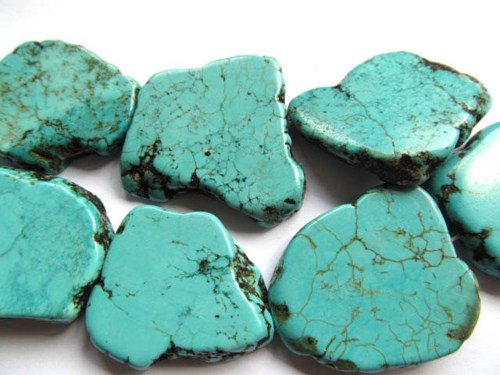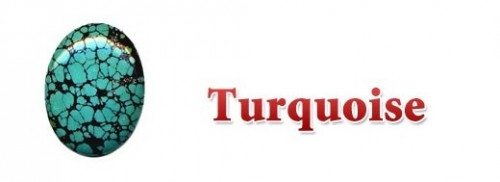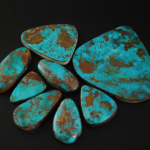Contents
Turquoise Information
Turquoise is one of the most popular and old stone, used from ancient times by Egyptians and Aztecs as a decorative stone, also used by native americans in their jewels, Turquoise is considered a very powerful and magical stone is also one of the most important opaque stone.
Its name derives from the french term “turquie” that means “turkish stone”, the color name comes from the appearance of this beautiful stone, caused by the contamination of the copper
It can display different shade of blue and green colors with often the presence of natural veins of brownish oxides or sandstone base with a porous surface, natural gemstones are usually treated to levigate and polish the stone surface.
This kind of stone comes usually opaque in some rare case can be translucent, often in Turquoise can be found brown or black veiny inclusions of matrix or other minerals, the most rare and desirable turquoise is translucent, without visible veins, however, sometimes veined turquoise which has unique intricate patterns resembling the spider web (spider web turquoise) are considered very attractive by some customers.
Click here to buy natural Turquoise stones for sale

Turquoise Healing Properties
Considered from the ancient population a magical stone, Turquoise is still nowadays considered an amulet or a talisman that brought good luck, longevity, protection for travelers, bring benefits for ears, eyes, brain and throat.
Associated with the third chakra, Turquoise is the traditional December birthstone and associated with Sagittarius zodiac sign.
A legend say that it can switch its color duo to the health of the wearer, fading if the wearer is ill or brighter if the wearer health is good.
Treatment
This beautiful stone comes with a very porous surface. Duo to its porosity that make it difficult to polish it and give nice luster, some stones are often “stabilized”, a common term to identify the treated stones by impregnation with other elements like oil, wax, polymers, plastic and cleaners to enhance its luster.
Unfortunately often this stone is also dyed to enhance or change its color, this kind of treatment is considered unacceptable and must be disclosed by the seller.
Origin and gemstone source
Original source of this material are: Iran,Egypt, Israel, but nowadays Turquoise can also be mined in: Afghanistan, Mexico, Australia, Chile, China and in the United States (Arizona and Nevada).
Optical Effect
Unfortunately it doesn’t produce any remarkable optical effect.
Photos and images
Click here to buy natural Turquoise stones for sale
Uses
Usually shaped and polished into cabochon stone, natural Turquoise is often carved into sculptures, or cut for inlay works, sometimes can also be faceted into the most common faceted cut.
Low grade material can also be used to make beads, rondelle, chips and similar, or tumbled to make some good looking stones for garden or crystal therapy.
Care and Cleaning
It is considered a soft stone and duo to its porosity deserve some care when cleaned. First you must avoid any aggressive cleaner or chemical products, but also perfume, common detergent, soap and skin oil can damage theTurquoise luster, so use only cold water to clean it and dry it with a soft cloth.
If you are a jeweler or a silversmith avoid direct flame on stone or eccessive heat, be careful when set it into jewel because this material is relatively soft with 5-6 on the Mohs hardness mineral scale. Store it separately from other harder stone or it will be easily scratched and may lose its beauty.
Some impregnated or dyed stone are not stabilized so they can easily lose their luster and color fastly.
Scam and Fraud
This is a popular stone found in abundance, but often some unscrupulous sellers try to scam inexpert buyers, selling them dyed Howlite for natural Turquoise. This is the main scam often found on the gem market, but sometimes some stones for sale are not completely natural, these stones are called paste of Turquoise and is an agglomeration of material glued or waxed together to resemble natural stones.
This stone contains copper, but it not the only, in fact there is other material with similar aspect that resemble the Turquoise appearance but more affordably and cheaper, like: Malachite, Chrysocolla, Variscite, Amazzonite, Odontolite sometime these materials are erroneously sold for natural stones.
Typical Internal Inclusions
Most untreated natural Turquoise has dark-grey, brown or black veiny inclusions of matrix or other minerals. Sometimes these inclusions can design very attractive patterns like a spider web.
Click here to buy natural Turquoise stones for sale
Gemological Info
- Mineral family: Turquoise
- Crystal: Tryclinic botryoidal
- Density: 2.31 – 2.84
- Hardness: 5 – 6 on the Mohs scale
- Refractive index: 1.610 – 1.650
- Color: Light blue to green
- Optical effect: None
- Luster: Waxy
- Clarity: Opaque (sometimes in rare case transparent)
- Fluorescent: Weak
- Fracture: Conchoidal
- Cleavage: None
- Durability: Medium Low







